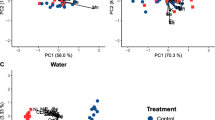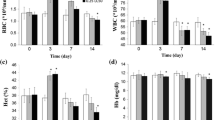Abstract
Heat shock protein (hsp70) expression, changes inliver ultrastructure, and alterations of swimmingbehavior were simultaneously investigated in browntrout (Salmo trutta f. fario) exposed towater from test streams in southern Germany undersemi-field conditions during 1995 and 1996. Chemicalanalyses revealed different levels of contamination ofthe two streams by pesticides, PAHs, PCBs, and heavymetals, whereas stream pollution was only partlyreflected by body burdens of contaminants in fish.Biomarker responses were compared after differenttimes of exposure and with respect to differenttemperature conditions. Differences in pollutionstates of the streams were reflected by differentbiomarker responses of the trout. In the highlycontaminated stream, the biomarker responses were morecoincident with one another than in the moderatelypolluted stream in which the biomarkers showed littlerelation to one another. This is primarily due to thedifferential capacities of the biomarkers to integratestress responses over time. Understanding the dynamicsof the stress response curves and the effects oftemperature on biomarker responses is essential forevaluating the effects of environmental stressors suchas contaminants on the health of organisms.
Similar content being viewed by others
References
Adam, S., E. Müller, M. Pawert, M. Schramm & R. Triebskorn, 1996. Effects of various environmental factors on benthic macroinvertebrate communities in small streams. 6th SETAC Europe Annual Meeting, Taormina, p. 236.
Adams, S.M., K.L. Shepard, M.S. Greeley Jr., M.G. Ryon, B.D Jimenez, L.R. Shugart, J.F. McCarthy & D.E. Hinton, 1989. The use of bioindicators for assessing the effects of pollutant stress in fish. Mar. Environ. Res. 28: 459–464.
Adams S.M., 1990. Status and use of bioindicators for evaluating effects of chronic stress on fish. Am. Fish. Soc. Symp. 8: 1–8.
Adams, S.M., W.D. Crumby, M.S. Greeley Jr., M.G. Ryon & E.M. Schilling, 1992a. Relationships between physiological and fish population responses in a contaminated stream. Env. Toxicol. Chem. 11(11): 1549–1557.
Adams, S.M., W.D. Crumby, M.S. Greeley Jr., L.R. Shugart & C.F. Saylor, 1992b. Responses of fish populations and communities to pulp mill effluents: a holistic assessment. Ecotox. Environ. Saf. 24(3): 347–360.
Adams, S.M., K.D. Ham, M.S. Greeley Jr., R.F. Lehew, D.E. Hinton & C.F. Saylor, 1996. Downstream gradients in bioindicator responses: Point source contaminant effects on fish health. Can. J. Fish. Aquat. Sci. 53(10): 2177–2187.
Beyer, J., M. Sandvik, K. Hylland, E. Fjeld, E. Egaas, E. Aas, J.U. Skare & A. Goksoyr, 1996. Contaminant accumulation and biomarker responses in flounder(Platichthys flesusL.) and Atlantic cod (Gadus morhuaL.) exposed by caging to polluted sediments in Sorfjorden, Norway. Aquat. Toxicol. 36(1–2): 75–98.
Bradford M.M., 1976. A rapid and sensitive method for the quantification of microgram quantities of protein utilizing the principle of protein-dye binding. Anal. Biochem. 72: 248–254.
Braunbeck, T., G. Göre, V. Storch & R. Nagel, 1990a. Hepatic steatosis in zebra fish (Brachydanio rerio) induced by long-term exposuret o γ-hexachlocyclohexane. Ecotox. Environ. Saf. 19: 355–374.
Braunbeck, T., V. Storch & H. Bresch, 1990b. Species-specific reactions of liver ultrastructure in zebrafish (Brachydanio rerio) and trout (Salmo gairdneri) after prolonged exposure to 4-chloroaniline. Arch. Environ. Contam. Toxicol. 19: 405–418.
Braunbeck, T. & A. Völkl, 1991. Induction of biotransformation in the liver of eel (Anguilla anguillaL.) by sublethal exposure to dinitro-O-cresol: An ultrastructural and biochemical study. Ecotox. Environ. Saf. 21: 109–127.
Braunbeck, T. & A. Völkl, 1993. Toxicant-induced cytological alterations in fish liver as biomarkers of environmental pollution? A case study on hepatocellular effects of dinitro-O-cresol in golden ide (Leuciscus idus melanotus). In: T. Braunbeck, W. Hanke & H. Segner (eds), Fish Ecotoxicology and Ecophysiology. VCH, Weinheim, pp. 55–80.
Brumley, C.M., V.S. Haritos, J.T. Ahokas & D.A. Holdway, 1995. Validation of biomarkers of marine pollution exposure in sand fathead using Arochlor 1254. Aquat. Toxicol. 31(3): 249–262.
Bucheli, T.D. & K. Fent, 1995. Induction of cytochrome P450 as a biomarker for environmental contamination in aquatic ecosystems. Crit. Rev. Env. Sci. Technol. 25(3): 201–268.
Couch, J.A., 1975. Histopathological effects of pesticides and related chemicals on the liver of fishes. In: W.E. Ribelin & G. Migaki (eds), The Pathology of Fishes. The University of Wisconsin Press, pp. 559–584.
De Pomerai, D.I., 1996. Heat-shock proteins as biomarkers of pollution. Hum. Experiment Toxicol. 15: 279–285.
Depledge, M.H. & M.C. Fossi, 1994. The role of biomarkers in environmental assessment (2). Invertebrates. Ecotoxicology 3: 161–172.
Eckwert, H., G. Alberti & H.-R. Köhler, 1997 (in press). The induction of stress proteins (hsp) in Oniscus asellus(Isopoda) as a molecular marker of multiple heavy metal exposure. I. Principles and toxicological assessment. Ecotoxicology 6.
Ernst, W.H.O. & P.J. Peterson, 1994. The role of biomarkers in environmental assessment (4). Terrestrial plants. Ecotoxicology 3: 180–192.
Ewald G., 1995. Chronic measures of toxicant-induced effects of fish. Ann. Zool. Fenn. 32(3): 311–316.
Fader, S.C., Z. Yu & J.R. Spotila, 1994. Seasonal variations in heat shock proteins (hsp70) in stream fish under natural conditions. J. Therm. Biol. 19(5): 335–341.
Gerhardt A., 1996. Behavioural early warning responses to polluted water. Environ. Sci. & Pollut. Res. 3(2): 63–70.
Heining, P. & R.W. Hoffmann, 1993. Light-and electron microscope studies on the prolonged toxicity of trichlorethylene on rainbow trout (Oncorhynchus mykiss). Exp. Toxicol. Pathol. 45: 167–176.
Hinton, D.E., J.E. Klaunig & M.M. Lipsky, 1978. PCB-induced alterations in teleost liver. A model for environmental disease in fish. Mar. Fish. Rev. 19: 47–50.
Hinton, D.E., P.C. Baumann, G.R. Gardner, W.E. Hawkins, J.D. Hendricks, R.A. Murchelano & M.S. Okihiro, 1992. Histopathological biomarkers. In: R.J. Huggett, R.J. Kimerle, P.M. Mehrle & H.L. Bergman (eds), Biomarkers. Biochemical, Physiological, and Histological Markers of Anthropogenic Stress. Lewis Publishers, Boca Raton, pp. 155–209.
Holdway, D.A., S.E. Brennan & J.T. Ahokas, 1995. Short review of selected fish biomarkers of xenobiotic exposurewith an example using fish hepatic mixed-function oxidase. Austr. J. Ecol. 20(1): 34–44.
Karnovsky M.J., 1971. Use of ferrocyanide-reduced osmium tetroxide in electron microscopy. J. Cell. Biol. 51: 284.
Köhler A., 1990. Identification of contaminant-induced cellular and subcellular lesions in the liver of flounder (Platichthys flesus L.) caught at differently polluted estuaries. Aquat. Toxicol. 16: 271–294.
Konradt, J., R. Triebskorn & T. Braunbeck, 1996. Comparative biochemical investigations in fish from polluted small rivers. Verh. Dt. Zool. Ges. 89: 159.
McCarthy, J.F. & L.R. Shugart, 1990. Biomarkers of environmental contamination. Lewis Publishers, Boca Raton, 457 pp.
Munkittrick, K.R. & L.S. McCarty, 1995. An integrated approach to aquatic ecosystem health: Top-down, bottom-up or middle-out? J. Aquat. Ecosyst. Health 4(2): 77–90.
Payne, J.F., A. Mathieu, W. Melvin & L.L. Fancey, 1996. Acetylcholinesterase, an old biomarker with a new future? Field trials in associaton with two urban rivers and a paper mill in Newfoundland. Mar. Poll. Bull. 32(2): 225–231.
Peakall D.B., 1994. The role of biomarkers in environmental assessment (1). Introduction. Ecotoxicology 3: 157–160.
Peakall, D.B. & C.H. Walker, 1994. The role of biomarkers in environmental assessment (3). Vertebrates. Ecotoxicology 3: 173–179.
Reynolds, E.S., 1963. The use of lead citrate at high pH as an electron-opaque stain in electron microscopy. J. Cell. Biol. 17: 208–212.
Rojik, I., J. Nemcsok & L. Boross, 1983. Morphological and biochemical studies on liver, kidney and gill of fishes affected by pesticides. Acta Biol. Hung. 34: 81–92.
Sachs L.; 1974. Angewandte Statistik. Springer, Berlin/Heidelberg, 545 pp.
Sanders, B.M. & L.S. Martin, 1993. Stress proteins as biomarkers of contaminant exposure in archived environmental samples. Sci. Tot. Environ. 139/140: 459–470.
Schramm, M., E. Müller & R. Triebskorn, in press. Assessment of small stream pollution using liver ultrastructure of brown trout (Salmo trutta f. fario) as a biomarker. Biomarkers.
Schwaiger, J., R. Triebskorn, H.-R. Köhler, M. Schramm, M. Pawert & T. Braunbeck, 1996. Histopathological studies contribute to the interpretation of biochemical marker responses. 6th SETAC Europe Annual Meeting, Taormina, p. 106.
Schwaiger, J., R. Wanke, S. Adam, M. Pawert, W. Honnen & R. Triebskorn, 1997. The use of histopathological indicators to evaluate contaminant-related stress in fish. J. Aquat. Ecosyst. Stress Recov. 6: 75–86.
Singh I., 1964. A modification of the Masson-Hamperl method for staining of argentaffin cells. Anat. Anz. 115: 81.
Sleiderink, H.M., J. Beyer, E. Scholtens, A. Goksoyr, J. Nieuwenhuize, J.M. van Liere, J.M. Everaarts & J.P. Boon, 1995. Influence of temperature and polyaromatic contaminants on Cyp1A levels in North sea dab (Limanda limanda). Aquat. Toxicol. 32(2–3): 189–209.
Storch V., 1985. Die Zelle als Spiegel der Umwelt. Umschau 1: 21–23.
Triebskorn, R., H.-R. Köhler, J. Flemming, T. Braunbeck, R.-D. Negele & H. Rahmann, 1994. Evaluation of bis(trinbutyltin)oxide (TBTO) neurotoxicity in rainbow trout (Oncorhynchus mykiss) I. Behaviour, weight increase, and tin contents. Aquat. Toxicol. 30: 189–197.
Triebskorn, R., I.F. Henderson, A. Martin & H.-R. Köhler, 1996. Slugs as target and non-target organisms for environmental pollution. In: I.F. Henderson (ed), Slug and Snail Pests in Agriculture. Brit. Crop. Prot. Counc. 66: 65–72.
Triebskorn, R., D. Frahne, W. Honnen, T. Braunbeck, J. Schwaiger, H.-R. Köhler, H. Segner, G. Schüürmann & A. Oberemm, 1997. Validierung und Einsatz biologischer, chemischer und mathematischer Tests und Biomarkerstudien zur Bewertung der Belastung kleiner Fließgewässer mit Umweltchmeikalien. Report for the German Ministry for Education, Science, Research, and Technology, FKZ 07OTX21-25.
van der Oost, R., L. van Gastel, D. Worst, M. Hanraads, K. Satumalay, F. van Schooten, H. Hedia & N.P. E. Vermeulen, 1994. Biochemical markers in feral roach (Rutilus rutilus) in relation to the bioaccumulation of organic trace pollutants. Chemosphere 29(4): 801–817.
van der Oost, R., A. Goksoyr, M. Celander, H. Heida & N.P.E. Vermeulen, 1996. Biomonitoring of aquatic pollution with feral eel (Anguilla anguilla): II. Biomarkers: Pollution-induced biochemical responses. Aquat. Toxicol. 36(3–4): 189–222.
van Gestel, C.A.M. & T.C. van Brummelen, 1996. Incorporation of the biomarker concept in ecotoxicology calls for a redefinition of terms. Ecotoxicology 5: 217–225.
Weibel, E.R. (1979) Stereological Methods 1: Academic Press, New York, London.
Weibel, E.R., H.R. Stäubli, H.R. Gnägi & F.A. Hess, 1969. Correlated morphometric and biochemical studies on the liver cell. I. Morphometric model, stereologic methods, and normal morphometric data for rat liver. J. Cell. Biol. 42: 68–91.
Wolkers, J., E.H. Jorgensen, S.M. Nijmeijer & R.F. Witkamp, 1996. Time-dependant induction of two distinct hepatic cytochrome P4501A catalytic activities at low temperatures in Arctic charr (Salvelinus alpinus) after oral exposure to benzo(a)pyrene. Aquat. Toxicol. 35(2): 127–138.
Zylstra S.J., 1994. A new program for biomonitoring status and trends in the environment. J. Aquat. Ecosys. Health 3(2): 81–85.
Author information
Authors and Affiliations
Rights and permissions
About this article
Cite this article
Triebskorn, R., Köhler, HR., Honnen, W. et al. Induction of heat shock proteins, changes in liver ultrastructure, and alterations of fish behavior: are these biomarkers related and are they useful to reflect the state of pollution in the field?. Journal of Aquatic Ecosystem Stress and Recovery 6, 57–73 (1997). https://doi.org/10.1023/A:1008224301117
Issue Date:
DOI: https://doi.org/10.1023/A:1008224301117




